Giant Hogweed was Introduced in the 19th century by the Victorians as an ornamental plant and it’s been on the march ever since, working its way across the UK and fraternizing with our Common Hogweed, (Heracleum sphondylium) along the way to produce Hybrids of Hogweed. The main thing we’ll be looking at through this article is the issues this could have on foraging and consuming common hogweed as this hybridization continues, with more ferocity, through the future. What do we need to look out for with hybridising common & Giant Hogweed & what’s the best practice to ensure what we’re picking is safe to consume?
An article researched and written by Forager Vicky
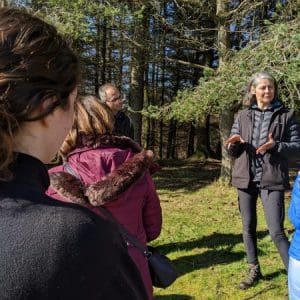
Scottish Forager and Herbalist Monica Wilde describes the two, common & Giant Hogweed as this:
“The difference between common and giant hogweed is like going to the pub on a night out. Giant hogweed is the drunk, aggressive, muscular guy on steroids. He’s all pumped up and itching for a fight. Just brush against him, not even spilling his drink, and he will attack you viciously. Common hogweed, on the other hand, is the quiet, wiry, calm guy at the end of the bar. Brush against him, even spill his pint, and he’ll accept your apology and carry on with his pint. But if you try to wipe out his entire family with a huge killing machine, then you’re in trouble!”
Monica Wilde
Do The Hogweed Plants Burn You?
Nearly every year we see articles about people being seriously burnt by ‘hogweed’ plants, I’m actually fairly certain the same image is used year on year and I’m not 100% certain that the image used is from an actual reaction to hogweed. However, it gets the point across that we need to be a little more wary when looking to forage for and harvest any of the Hogweeds.
So let’s take a look at the different types of hogweed and which may cause a burning type reaction…
Brush gently against Heracleum mantegazzianum (Giant Hogweed) and you could end up with a serious phototoxic reaction, resulting in painful blisters that may even require skin grafts. Heracleum sphondylium (common hogweed), however, is much safer. You’ll only get a serious phototoxic reaction if you are cutting the stems in direct sunlight and allowing the sap to contact your skin. Simply brushing against the leaves of common hogweed will cause little effect. That said, in certain circumstances, Heracleum sphondylium (common hogweed) can cause just as much pain as its big cousin, if not given the respect it deserves, plus if you inadvertently decide to pick some of the offspring of the two, then you may find yourself in trouble.
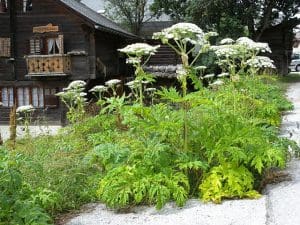
What’s actually going on here with The Hogweed Plants?
Both Heracleum mantegazzianum (Giant Hogweed). and Heracleum sphondylium (Common Hogweed) contain photo toxic phytochemicals called furanocoumarins.
This group of photo toxic chemicals are protection against biological attack. If the plants are being physically attacked either biologically, as in a mould, or mechanically, such as a strimmer, a phytoalexin response will occur, triggering the production of furanocoumarins. A touch of the sap of plants containing furanocoumarins causes painful inflammation of the skin and long lasting sensitivity to sunlight, (Kirkensgaard, 2018).

Strimming is, quite probably, the most efficient way of ensuring the spray of furanocoumarins all over yourself from furious Heracleum species, as they muster their defences to wreak revenge on whatever is trying to shred them. It is well documented that you should always wear full body protection if you decide to take a strimmer to Heracleum sphondylium.
Furanocoumarins have enhanced toxicity in the presence of UV radiation. It was found that Heracleum species produced higher concentrations during warmer weather and under attack from moulds, (Hattendorf, et al., 2007). Chemical analysis of furanocoumarins in Heracleum species in the south of England were found to be higher than those of plants growing on sites in Scotland, (Tiley, et al., 1996), most likely because there are higher levels of UV radiation and for longer periods of time in southern England than Scotland.
Other plants that give a photo toxic reaction.
It’s worth noting that there are several other plants, not all of which are in the same family, that also contain furanocoumarins, including Limes, Lemons, Celery, Parsnip, Parsley and Fennel, all of which have been found capable of producing a photo toxic reaction.
In Ottawa, a 26 year old woman presented at hospital, with serious blistering on her hands, after squeezing Lemons and Limes for sangria and then spending the day outdoors with no sunscreen, (Mioduszewski & Beecker, 2015).

Image from https://www.ncbi.nlm.nih.gov/pmc/articles/PMC4185147/
There are also documented reports of serious photo toxic reactions after ingesting foods containing furanocoumarins. Celery is one of the most common allergens in the UK and Europe. Because it is often used as a “hidden” ingredient in many prepared foods, it is mandatory that all food businesses must declare the use of Celery in any prepared meal.

(Ljunggren, 1992), reported that a 65 year old woman who had consumed a large quantity of Celery root, developed a severe generalised reaction when she then used a sunbed.
Will The Hogweed Plants affect me more if I have fair skin?
Fair skinned people are more likely to suffer from a phototoxic reaction after ingesting foods or medication containing furanocoumarins, than dark skinned people after exposure to sunlight (Kaidbey K H et al (Kaideby, et al., 1979).
Theoretically, anyone can suffer from a photo toxic reaction if exposed to sap high in furanocoumarins, however, there are specific conditions to developing an oral allergy to Celery, (and Heracleum s sp.). This type of allergy would usually only occur if a person already has an allergy to certain types of pollen, including Birch, Alder and Mugwort, Pollen Food Syndrome, (PFS), H. Breiteneder et al, 1995 (Breiteneder, et al., 1995), or a genetic predisposition to develop an immune response to certain allergens. Most people will have no idea that they have an allergy until they experience swelling, tingling on their tongue or abdominal discomfort when eating particular foods.
Hogweed Hybrids
Plants of the same genus can be promiscuous and this is certainly the case between Heracleum sphondylium and Heracleum mantegazzianum. Because both species have the same number of chromosomes, hybridisation can occur, although hybrids only seem to survive where Heracleum sphondylium is the mother plant, not the other way round, (Stewart F, 1984).
First generation hybrids are easy to distinguish from their parents, being larger and with more rays in the primary umbel than Heracleum sphondylium and are more rapid in growth, (Weimarck G, 1979)
Although (Stewart F, 1984)), found that less than 20% of hybrids were fertile, it’s now known that there are at least 9 hybrids of Heracleum sphondylium across Europe, (Weimarck & Nilsonn, 1980)with their distribution unknown in the UK. When tested for levels of furanocoumarins the highest levels were found in the roots and the fruits, apart from the subspecies alpinum. When the leaves were tested for photo toxicity, it was found that generally, (but not always), Heracleum sphondylium L was non-photo toxic, with the hybrids having moderately to strong levels of furanocoumarins in the leaves. The stems of all the Heracleum sphondylium species were found to be moderate to highly photo toxic, (Weimarck & Nilsonn, 1980).
Click here to see our identification guide for Giant Hogweed
Click here to see our foraging guide for Common Hogweed
Conclusion on The Hogweed Plants
Overall, eating common hogweed is absolutely fine and actually a brilliant ingredient, if you find giant hogweed on site be very careful not to harvest any hybrids – I actually cut down the giant hogweed before it flowers & seeds so that it can’t breed with the common hogweed. Of course wearing thick gloves and using a very sharp knife.
Heracleum sphondylium (common hogweed) is safe to consume, although there is some safety advice that comes with this.
Safety advice for foraging & cooking Common Hogweed
- Always use a sharp knife or scissors to snip the leaf shoots or unopened flower buds. This will prevent any spray of the sap.
- You may also want to wear gloves so you don’t get any sap on your hands.
- There are much higher levels of furanocoumarins in plants during hot dry spells, so avoid collecting during these times.
- There are much higher levels of furanocoumarins in plants when they have a mould or yeast infection, so do not collect from plants that are compromised.
- Plants in the south of England contain much higher levels of furanocoumarins than those in Scotland, probably due to the higher summer temperatures and dryer climate. This is an important consideration if you live south of the border.
- Individuals who are allergic to celery should be very cautious about consuming Heracleum sphondylium, particularly during hotter weather.
- Individuals who suffer from hay fever, particularly from Birch, Mugwort and Alder pollen, should proceed with caution when consuming Heracleum sphondylium. If any tingling in the mouth, lips or tongue occurs, stop immediately.
- Individuals with fairer skin are more likely to have a phototoxic reaction both orally and on contact to Heracleum species.
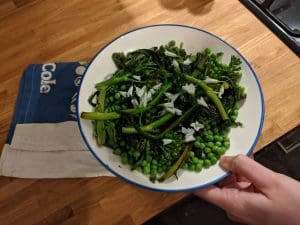
Common hogweed stems steamed with peas
Can I eat Hybrids of The Hogweed Plants?
Here’s a top tip list when you find giant hogweed on your local patch:
- Heracleum sphondylium hybrids, these are the common hogweed that has bred with giant hogweed, contain much higher levels of furanocoumarins and should not be gathered.
- Do not gather any Hercaleum spp. in areas where there are Heracleum mantegazzianum and Heracleum sphondylium growing in close proximity as there will most likely be hybrids.
- The dispersal of hybrids in the UK is currently unknown.
- If you are in any doubt as to whether you are looking at a hybrid, be sensible and leave well alone. Generally, Heracleum sphondylium will not reach more than about a metre in height. Hybrids tend to be bigger, with more rapid growth and more flower rays in the primary flower umbel.
Here’s our Common Hogweed Foraging Video
References
Find out more about Monica Wilde here
Breiteneder, H. et al., 1995. Moelcular Characterization of Api g 1, the Majot Allergen of Celery (Aium graveolens), and Its Immunological and Structual Relationships to a Group of 17-kDa Tree Pollen Allergens. European Journal of Biochemistry, 233(2).
Hattendorf, J., Hansen, S. & Nantwij, W., 2007. Defence Systems of Heracleum mantegazzianum. s.l.:s.n.
Kaideby, K., Agin, P., Sayre, R. & Kligman, A., 1979. Photoprotection by melanin-a comparison of black and caucasian skin. Journal of American Academy of Dermatology.
Kirkensgaard, K., 2018. Furanocoumarins-The Defence of Wild Parsnip and Giant Hogweed. NaToxAq.
Ljunggren, B., 1992. Severe Phototoxic Burn Following Celery Ingestion. JAMA Network, Volume Archives of Dermatology.
Mioduszewski, M. & Beecker, J., 2015. CMAJ.
Stewart F, G. J., 1984. An Experimental Study of Hybridization Between Heracleum mantegazzianum Smm. and Levier and Heracleum sphondylium L. subsp. sphondylium (Umbelliferae), Edinburgh: Deaprtment of Forestry and Natural Resources, University of Edinburgh.
Tiley, G., Felicite, S. & P.M, W., 1996. Heracleum mantegazzianum Sommier and Levier. Journal of Ecolgy.
Weimarck G, S. F. G. J. (., 1979. Morphometric and Chromatographic variation and male meiosis in the hybrid Heracleum mantegazzianum x H. sphondylium (Apiaceae) and its parents, s.l.: Wiley Online Library.
Weimarck, G. & Nilsonn, E., 1980. Phototoxicity in Heracleum sphondylium. Planta Medica.




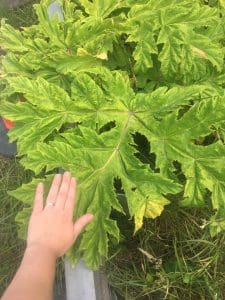
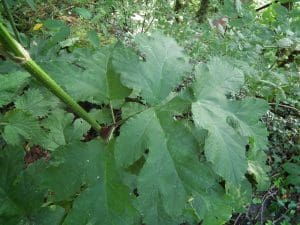



Leave a Reply
You must be logged in to post a comment.